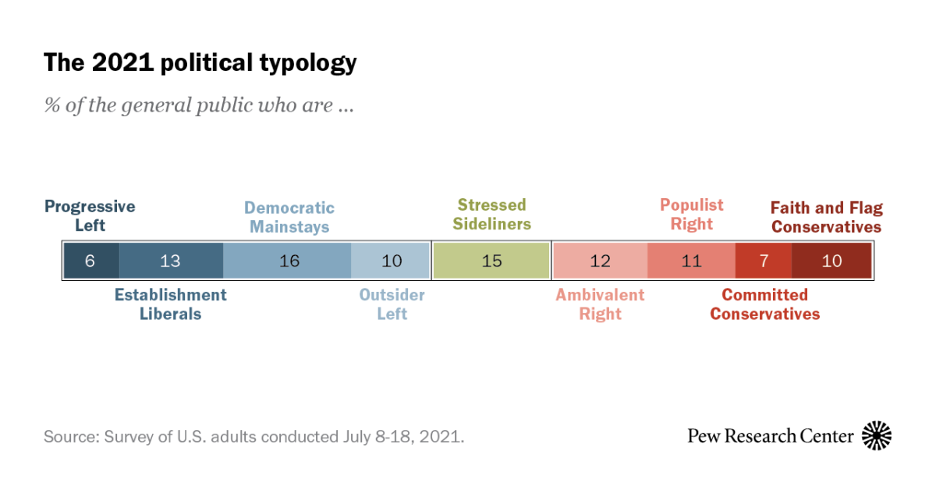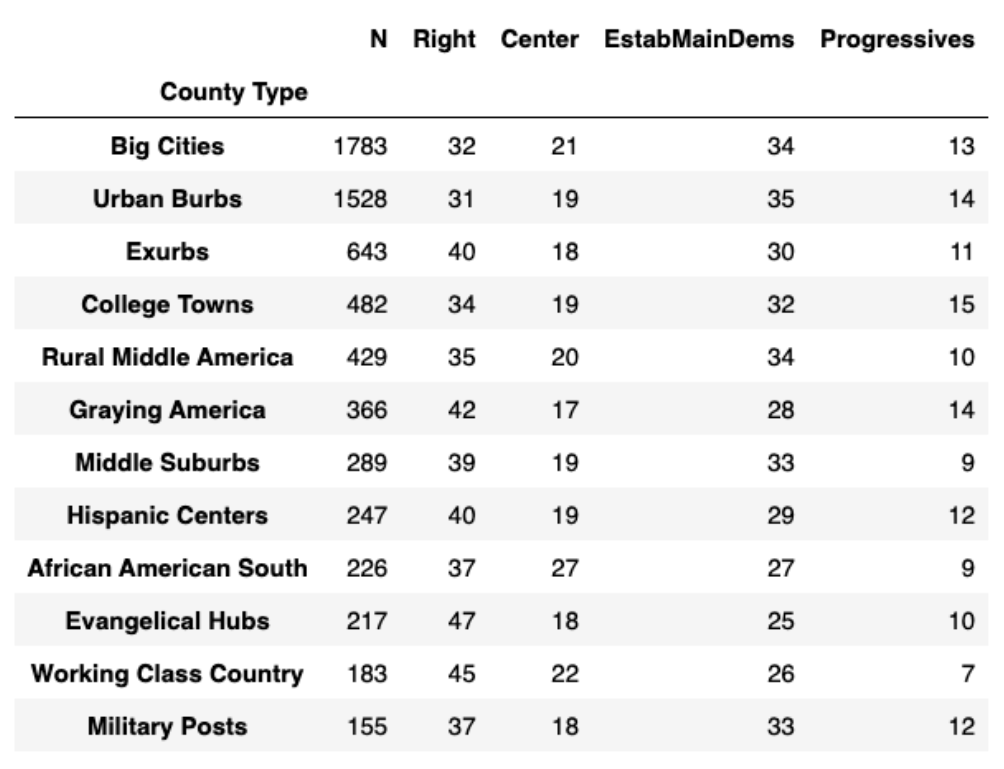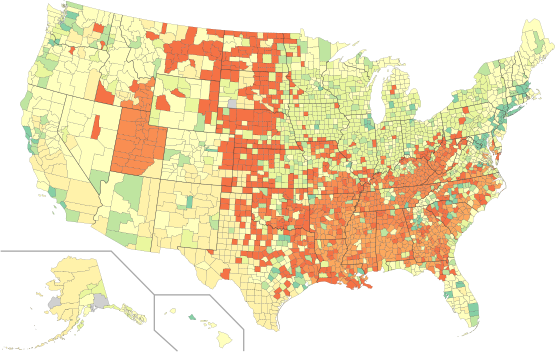The Political Left in American Communities
GivingTuesday Data Commons has been running a weekly national survey on generosity and identity in the U.S. for the past three years. We reported on what we learned about the Populist Right in July. Now we’re following up with insights about groups on the political left.
We use an eight-part question about one’s worldview to place people on the U.S. political spectrum, adapted from a Pew Research survey. Combining this with ACP’s model tells us how the current political landscape plays out in various community types.

When looking at Pew Political Types on the left, there are two factions that differ from each other often as much as they do from the center or the groups on the right. We will consider those two factions — Establishment Liberals and Democratic Mainstays — as a single group of liberals here.
The Progressive Left, on the other hand, differs from others on the left in believing that lack of equal justice under the law for all people, regardless of race or creed, is the single defining issue of our time.
The Outsider Left — the most ethnically diverse Pew group — tends to agree with the Progressive Left, but those who identify with the group don’t see themselves represented by the largely white progressives in office. The Outsider Left tends to flock to U.S. Rep. Alexandria Ocasio-Cortez of New York, but not U.S. Sens. Bernie Sanders of Vermont and Elizabeth Warren of Massachusetts.
All on the left broadly agree that the economic system is unfair, that big businesses are not paying their fair share of taxes, and that compromise is how things get done in politics.
Percent of Each County Type by Political Lean

(Footnote: We recoded LDS Enclaves as Evangelical Hubs, Aging Farmlands as Working Class Country, and Native American Lands as Hispanic Centers due to limited sample size, as those were the closest county types. All remaining groups had at least 150 respondents. County types are ordered by largest to smallest sample size.)
Trends by Community Type
- The left is most prevalent in four most densely populated county types, and least prevalent in rural county types, except for Graying America.
- Establishment Liberals and Democratic Mainstays are a larger faction (25-35% of population), least represented in Evangelical Hubs, Working Class Country, and African American South.
- The Progressive Left is consistently 9-15% of the population across the country, except in Working Class Country.
Map: Percent of left-leaning people by county type over the last 15 months, including Democratic Mainstays, Establishment Liberals, and Progressive Left.


(Footnote: To help visualize political lean across the country, all counties of a certain type are colored using the average for all respondents living in the respective county type; actual percentages per county shown will vary.)
The Left Divides Over Whether Government Is Working
- Establishment Liberals believe in government. Overall, 76% do not believe the government is “almost always wasteful and inefficient,” making it the only Pew group with strong faith in government.
- In the Democratic Mainstays group, most don’t think the government works for most people, in sharp contrast to the Establishment Liberals.
- In the Progressive Left group, about half think the government is wasteful, leading to frustration. Interestingly, Progressives have moved a lot on this point (Pew reported only 29% considered government wasteful in 2021, compared to 45% today).
Establishment Liberals and Democratic Mainstays form a reliable block of givers who drive civic engagement and community depolarization in the U.S. Together, these two groups share four traits:
- They are slightly more generous (giving any mix of time, treasure, talent, or voice to causes and groups), and are slightly more supportive of depolarizing actions/intents than other Pew groups across the political spectrum.
- They value community involvement: They are more likely to say that their most significant act last year was to volunteer regularly in their communities, though donating money remains the most common form of generosity for this group.
- These two groups are the most trusting of people of all Pew groups, and the only group for whom a majority generally trusts other people (at 56%).
- They support registered charities, informal groups, and give to individuals at higher rates than those on the Right, in the political center, or the Progressive Left. And they are equally likely to support a registered nonprofit as to help an individual person.
Divides Over Religion, Trust, and Activism
The Progressive Left and all those on the Right (Faith & Flag Conservatives, Committed Conservatives, Populist Right) differ in religiosity, trust, and activism.
- The Progressive Left is rarely religious: Only 39% were somewhat-to-very religious, compared to 76% on the Right. And 70% of those in the Center and Establishment Liberals were somewhat-to-very religious, similar to the Right, but they disagreed with the Right in believing that everyone should be religious.
- The Progressive Left tends to be the most trusting and the least skeptical of nonprofits and the services they provide of any group.
- The Progressive Left is about twice as likely as everyone else to have recently engaged in multiple forms of activism (petitions, advocating online, public protests, and/or boycotting), and about twice as likely as moderates or conservatives to cite “regular advocacy” as the “most significant” work they do to help others.
- The Progressive Left is solicited more often than those with any other political leaning. And 58% were solicited within a month of being surveyed. The least solicited are centrists, at 38%.
Taken together, the Progressive Left sees the world through a largely secular social-change lens. They put their faith and trust in secular institutions and informal activist communities, and tend to trust nonprofits a great deal, and trust individual people a bit less.
We will cover the centrist groups in a future post.
 Marc Maxmeister helps organize and convert the world’s generosity data into meaningful insights into how giving works, and what organizations can do to improve the lives of people served. He brings context from mixed methods field research in Africa, rigor from his Ph.D. work as a molecular neuroscientist, and engineering from past AI-driven startups and nonprofits.
Marc Maxmeister helps organize and convert the world’s generosity data into meaningful insights into how giving works, and what organizations can do to improve the lives of people served. He brings context from mixed methods field research in Africa, rigor from his Ph.D. work as a molecular neuroscientist, and engineering from past AI-driven startups and nonprofits.